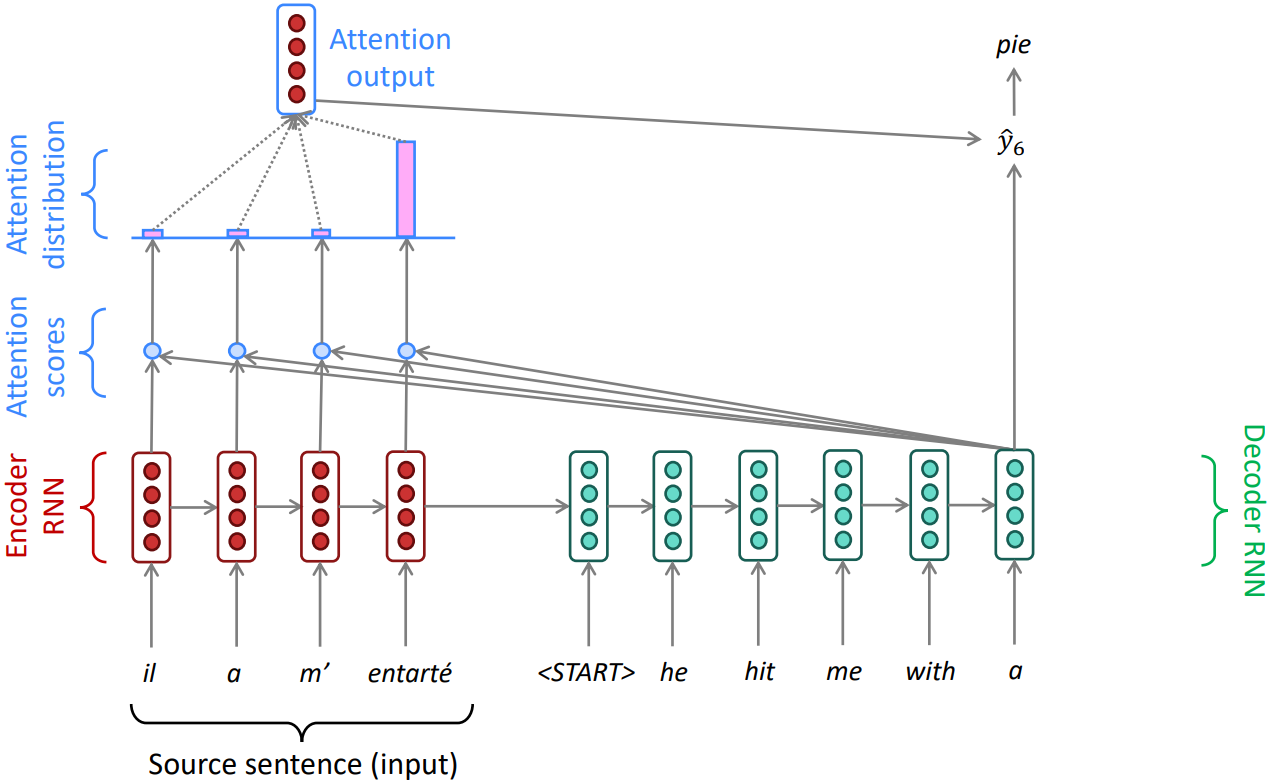cs224n - Lecture 7. Translation, Seq2Seq, Attention
New Task: Machine Translation
Pre-Neural Machine Translation
Machine Translation (MT) is the task of translating a sentence x from one language (the source language) to a sentence y in another language (the target language).
1990s-2010s: Statistical Machine Translation
- Core idea: Learn a probabilistic model from data
- Find best translated sentence y, given sentence x
$\text{argmax}_y P(y|x)$
- Find best translated sentence y, given sentence x
- Use Bayes Rule to break this down into two components to be learned separately:
$= \text{argmax}_y P(x|y)P(y)$- $P(x\vert y)$: Translation model that models how words and phrases should be translated (fidelity); Learnt from parallel data.
- $P(y)$: Language Model that models how to write good English (fluency). Learnt from monolingual data.
- Question: How to learn translation model $P(x\vert y)$?
- First, need large amount of parallel data
(e.g., pairs of human-translated French/English sentences)
- First, need large amount of parallel data
Learning alignment for SMT
-
Question: How to learn translation model $P(x\vert y)$ from the parallel corpus?
-
Break it down further: Introduce latent a variable into the model:
$P(x, a|y)$
where a is the alignment, i.e. word-level correspondence between source sentence x and target sentence y

-
Alignment is the correspondence between particular words in the translated sentence pair, capturing the grammatical differences between languages. Typological differences lead to complicated alignments.
-
Alignment is complex:
Some words have no counterpart
Alignment can be many-to-one, one-to-many, or many-to-many(phrase-level) - We learn $P(x, a\vert y)$ as a combination of many factors, including:
- Probability of particular words aligning (also depends on position in sent)
- Probability of particular words having a particular fertility (number of corresponding words)
- etc.
- Alignments a are latent variables: They aren’t explicitly specified in the data
- Require the use of special learning algorithms (like Expectation-Maximization) for learning the parameters of distributions with latent variables
Decoding for SMT
- How to compute $\text{argmax}_y$?
- Translation Model $P(x\vert y)$
- Language Model $P(y)$
- Enumerating every possible y and calculate the probability is too expensive;
$\rightarrow$ Impose strong independence assumptions in model, use dynamic programming for globally optimal solutions (e.g. Viterbi algorithm). This process is called decoding.
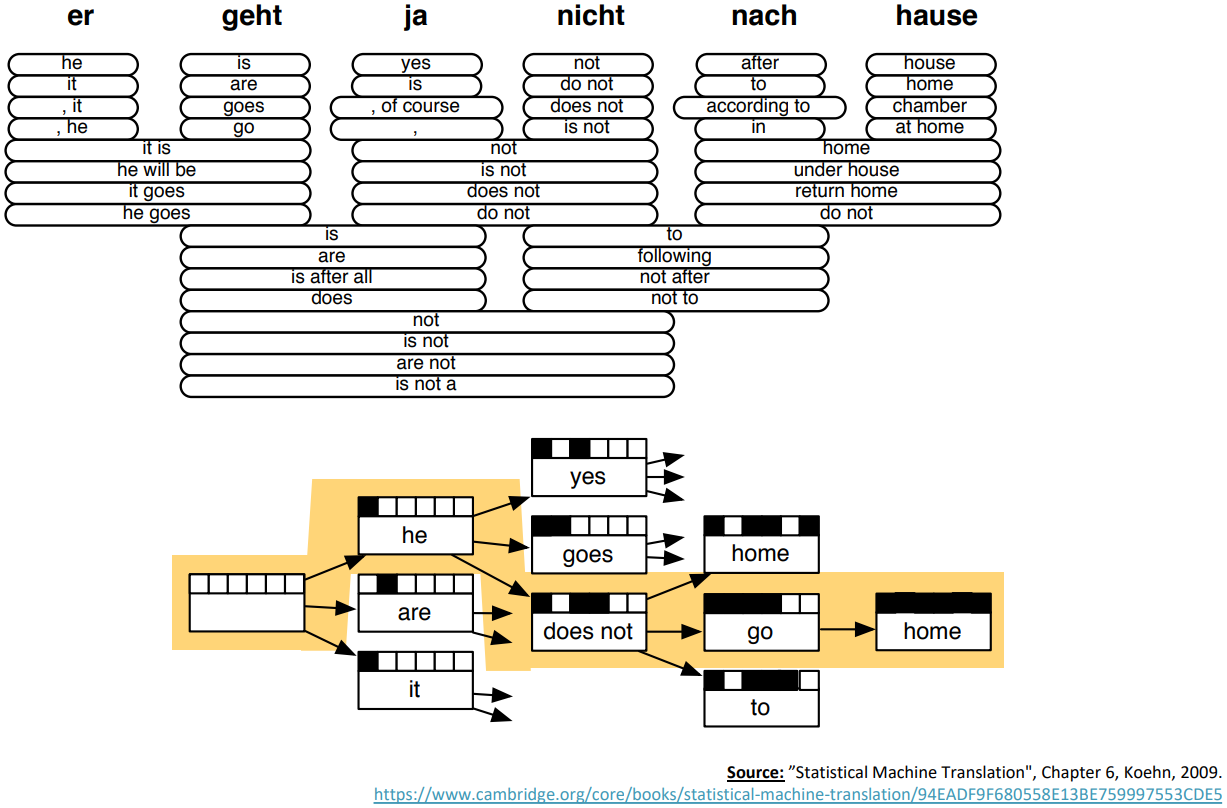
about SMT
- SMT was a huge research field
- The best systems were extremely complex
- Hundreds of important details we haven’t mentioned here
- Systems had many separately-designed subcomponents
- Lots of feature engineering; need to design features to capture particular language phenomena
- Require compiling and maintaining extra resources (like tables of equivalent phrases)
- Lots of human effort to maintain; repeated effort for each language pair
- Fairly successful, Google Translate launched in mid 2000s.
Neural Machine Translation (2014~)
-
Neural Machine Translation (NMT) is a way to do Machine Translation with a single end-to-end neural network
-
The neural network architecture is called a sequence-to-sequence model (aka seq2seq) and it involves two RNNs
Sequence-to-sequence Model
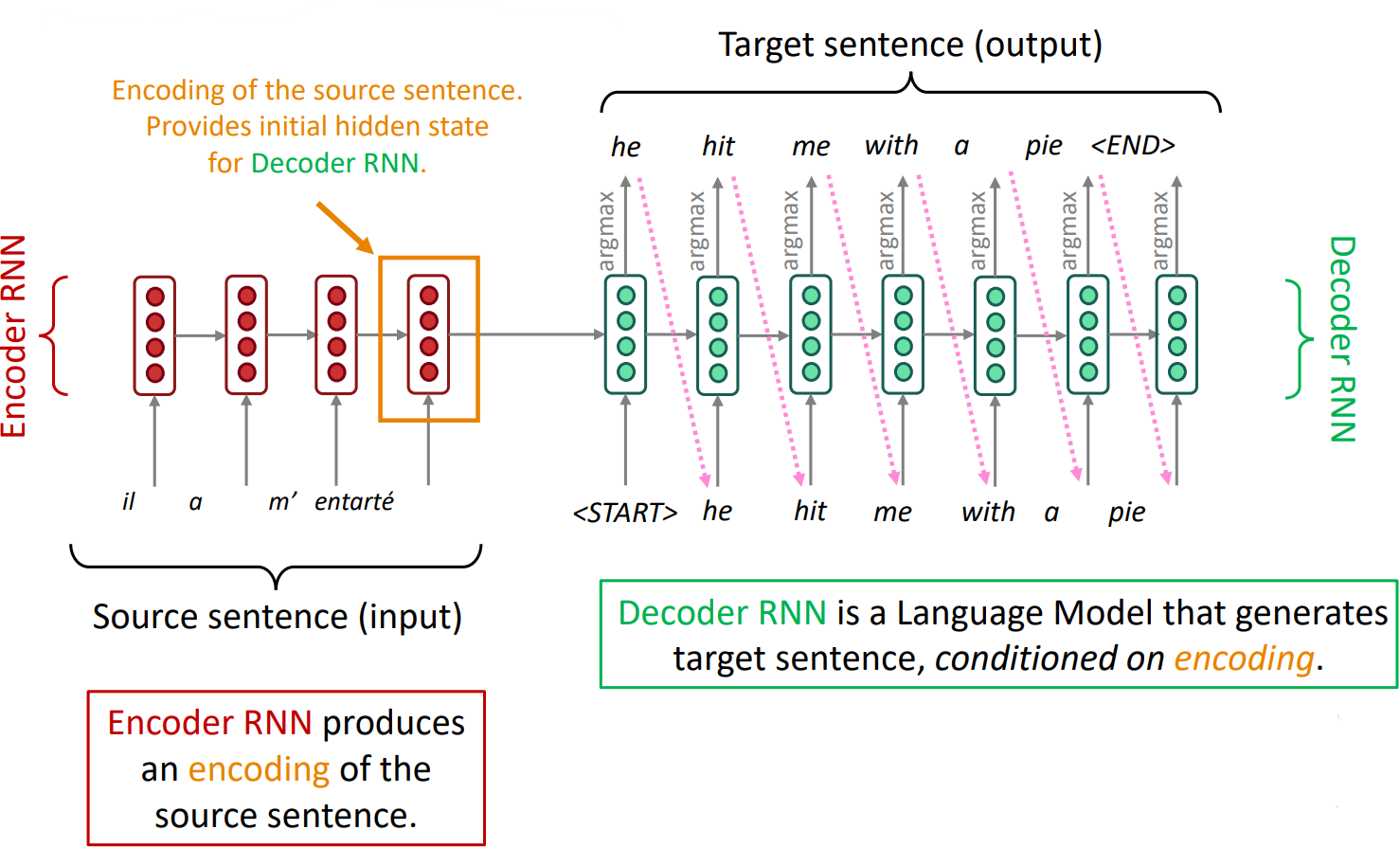
(Note: This diagram shows test time behavior: decoder output is fed in as next step’s input)
- Sequence-to-sequence is useful for more than just MT
Many NLP tasks can be phrased as sequence-to-sequence:- Summarization (long text $\rightarrow$ short text)
- Dialogue (previous utterances $\rightarrow$ next utterance)
- Parsing (input text $\rightarrow$ output parse as sequence)
- Code generation (natural language $\rightarrow$ Python code)
- An example of a Conditional Language Model
- Language Model because the decoder is predicting the next word of the target sentence y
- Conditional because its prediction are also conditioned on the source sentence x
-
NMT directly calculates $P(y\vert x)$:
$P(y|x) = P(y_1|x)P(y_2|y_1,x)P(y_3|y_1,y_2,x)\ldots P(y_T|y_1,\ldots, y_{T-1}, x)$ - Question: How to train a NMT system?
Training a Neural Machine Translation system
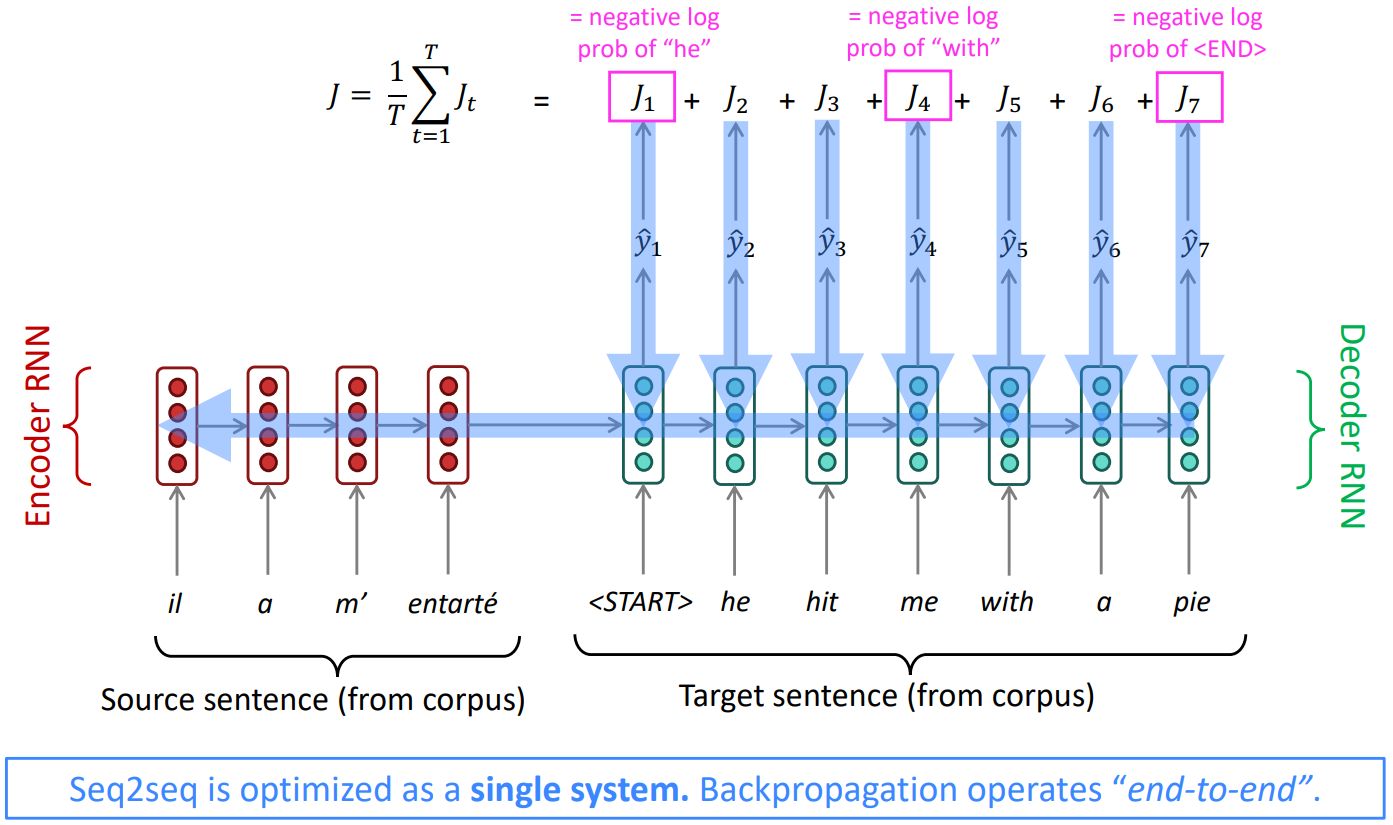
- End-to-End: update all of the parameters of the both encoder and decoder.
Multi-layer RNNs
- RNNs are already “deep” on one dimension (they unroll horizontally over many timesteps), but shallow; a single layer of recurrent structure about the sentences.
- We can also make them “deep” in another dimension by applying multiple RNNs - a multi-layer RNN(or stacked RNNs). This allows the network to compute more complex representations; The lower RNNs should compute lower-level features and the higher RNNs should compute higher-level features.
- It’s not same: four LSTMs with a hidden state 500 each are more powerful than one 2000 layer LSTM (though we have the same number of parameters roughly).
Multi-layer deep encoder-decoder machine translation net
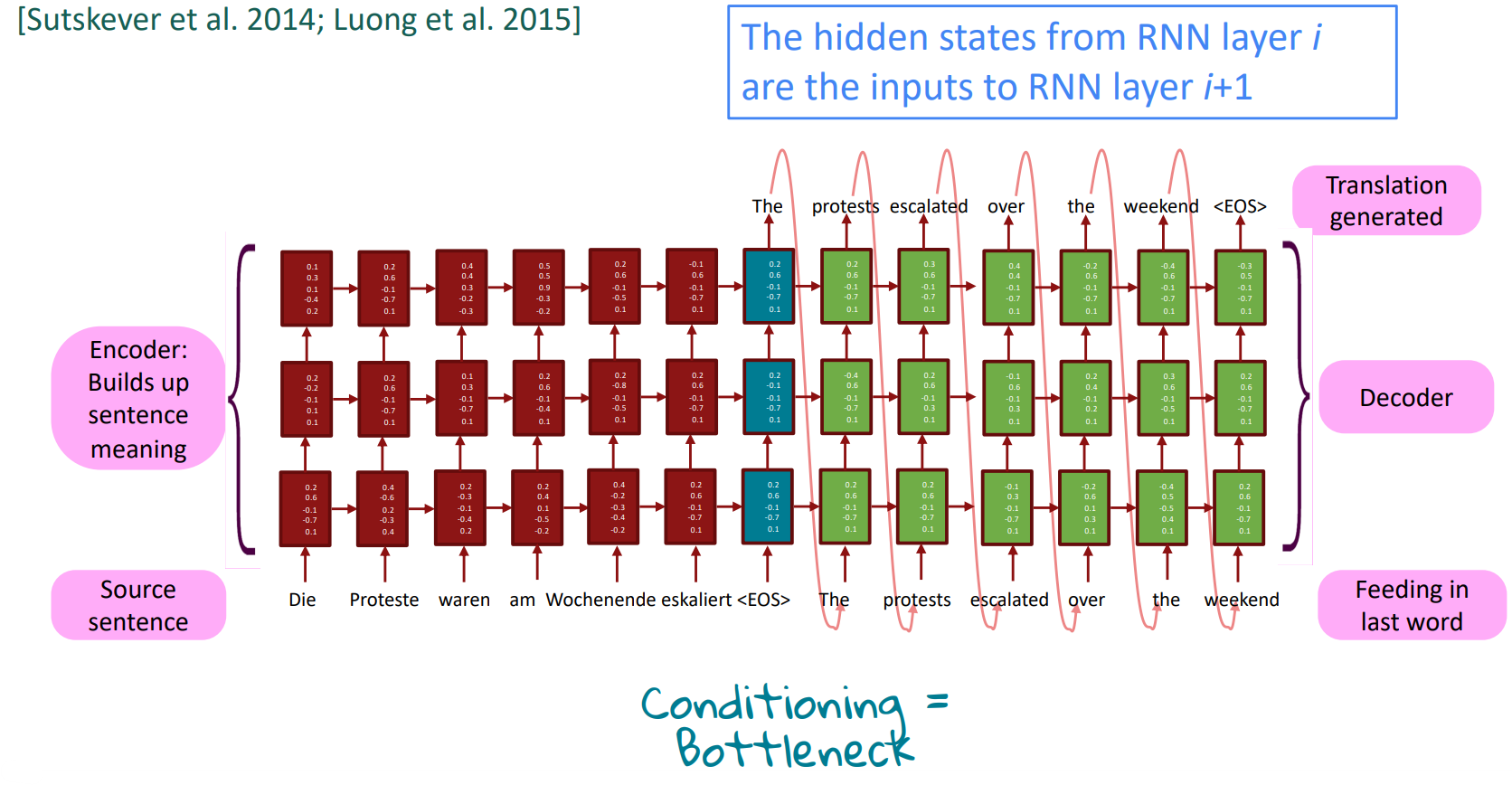
Multi-layer RNNs in practice
-
High-performing RNNs are usually multi-layer (but aren’t as deep as convolutional or feed-forward networks)
- For example: In a 2017 paper, (“Massive Exploration of Neural Machine Translation Architecutres”, Britz et al.) find that for Neural Machine Translation, 2 to 4 layers is best for the encoder RNN, and 4 layers is best for the decoder RNN
- Often 2 layers is a lot better than 1, and 3 might be a little better than 2 (rules of thumb)
- Usually, skip-connections/dense-connections are needed to train deeper RNNs (e.g., 8 layers)
- Transformer-based networks (e.g., BERT) are usually deeper, like 12 or 24 layers having a lot of skipping-like connections.
Greedy Decoding
- Greedy decoding(take most probable word on each step) is what we saw so far; taking argmax on each step of the decoder
- Problem: has no way to undo decisions
Exhaustive search decoding
-
Ideally, we want to find a (length T) translation y that maximizes
\(\begin{align*} P(y|x) &= P(y_1|x)P(y_2|y_1,x)P(y_3|y_1,y_2,x)\ldots P(y_T|y_1,\ldots, y_{T-1}, x) \\ &= \prod_{t=1}^T P(y_t|y_1,\ldots,y_{t-1},x) \end{align*}\) -
We could try computing all possible sequences y
- This means that on each step t of the decoder, we’re tracking $V^t$ possible partial translations, where V is vocab size
- This $O(V^T)$ complexity is far too expensive
Beam search decoding
- Core idea: On each step of decoder, keep track of the k most probable partial translations (which we call hypotheses)
- k is the beam size (in practice around 5 to 10)
- A hypothesis $y_1, \ldots, y_t$ has a score which is its log probability:
$\text{score}(y_1, \ldots, y_t) = \log P_{LM}(y_1, \ldots, y_t|x) = \sum_{i=1}^t \log P_{LM}(y_i|y_1, \ldots, y_{i-1},x)$- Scores are all negative, and higher is better
- Search for high-scoring hypotheses, tracking top k on each step
-
Not guaranteed to find optimal solution, but much more efficient
- Stopping criterion
- In greedy decoding, usually we decode until the model produces an
<END>token (“<START>he hit me with a pie<END>”) - In beam search decoding, different hypotheses may produce
<END>tokens on different timesteps- When a hypothesis produces
<END>, that hypothesis is complete. - Place it aside and continue exploring other hypotheses via beam search.
- When a hypothesis produces
- Usually continue beam search until:
- We reach timestep T or we have at least n completed hypotheses (where T and n are some pre-defined cutoff)
- In greedy decoding, usually we decode until the model produces an
- Finishing up
- We have our list of completed hypotheses. Then how to select top one with highest score?
- Each hypothesis $y_1,\ldots, y_t$ on our list has a score:
\(\text{score}(y_1, \ldots, y_t) = \log P_{LM}(y_1, \ldots, y_t|x) = \sum_{i=1}^t \log P_{LM}(y_i|y_1, \ldots, y_{i-1},x)\) - Problem: longer hypotheses have lower scores
- Fix: Normalize by length.
\(\frac{1}{t}\sum_{i=1}^t \log P_{LM}(y_i|y_1, \ldots, y_{i-1},x)\)
Advantages of NMT
-
Better performance:
More fluent
Better use of context
Better use of phrase similarities -
A single neural network to be optimized end-to-end
No subcomponents to be individually optimized -
Requires much less human engineering effort
No feature engineering
Same method for all language pairs
Disadvantages of NMT
-
Less interpretable
Hard to debug -
Difficult to control
For example, can’t easily specify rules or guidelines for translation
Safety concerns
How do we evaluate Machine Translation?
- BLEU (Bilingual Evaluation Understudy)
Compares the machine-written translation to one or several human-written translation(s), and computes a similarity score based on:- n-gram precision (usually 1 to 4)
- Plus a penalty for too-short system translations
- Useful but imperfect
There are many valid ways to translate a sentence
So a good translation can get a poor BLEU score because it has low n-gram overlap with the human translation
MT progress over time
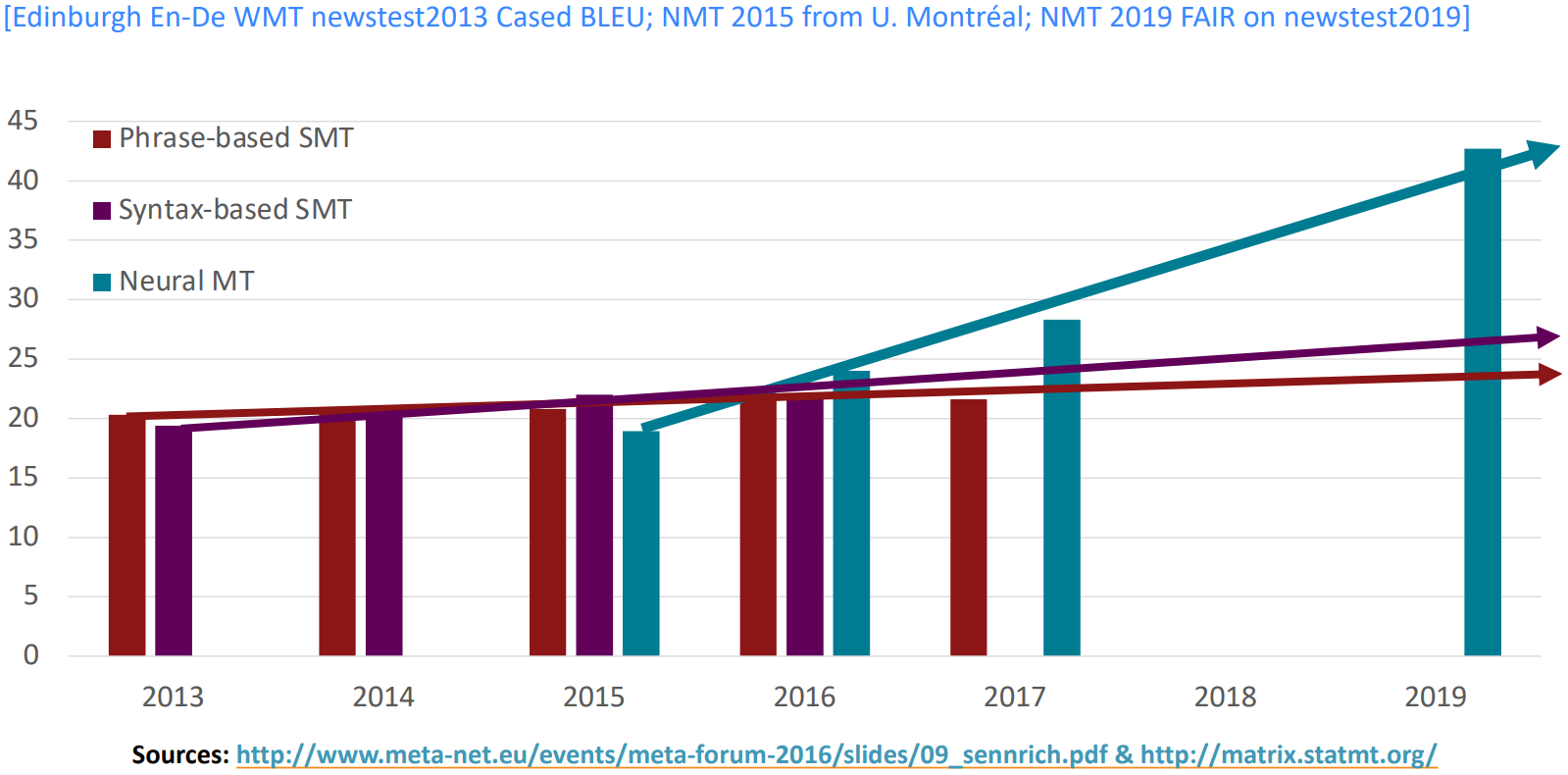
- NMT: perhaps the biggest success story of NLP Deep Learning?
Neural Machine Translation went from a fringe research attempt in 2014 to the leading standard method in 2016- 2014: First seq2seq paper published
- 2016: Google Translate switches from SMT to NMT – and by 2018 everyone has
- SMT systems, built by hundreds of engineers over many years, outperformed by NMT systems trained by a small group of engineers in a few months
- Many difficulties remain:
- Out-of-vocabulary words
- Domain mismatch between train and test data
- Maintaining context over longer text
- Low-resource language pairs
- Failures to accurately capture sentence meaning
- Pronoun (or zero pronoun) resolution errors
- Morphological agreement errors
- Bias in training data
ATTENTION
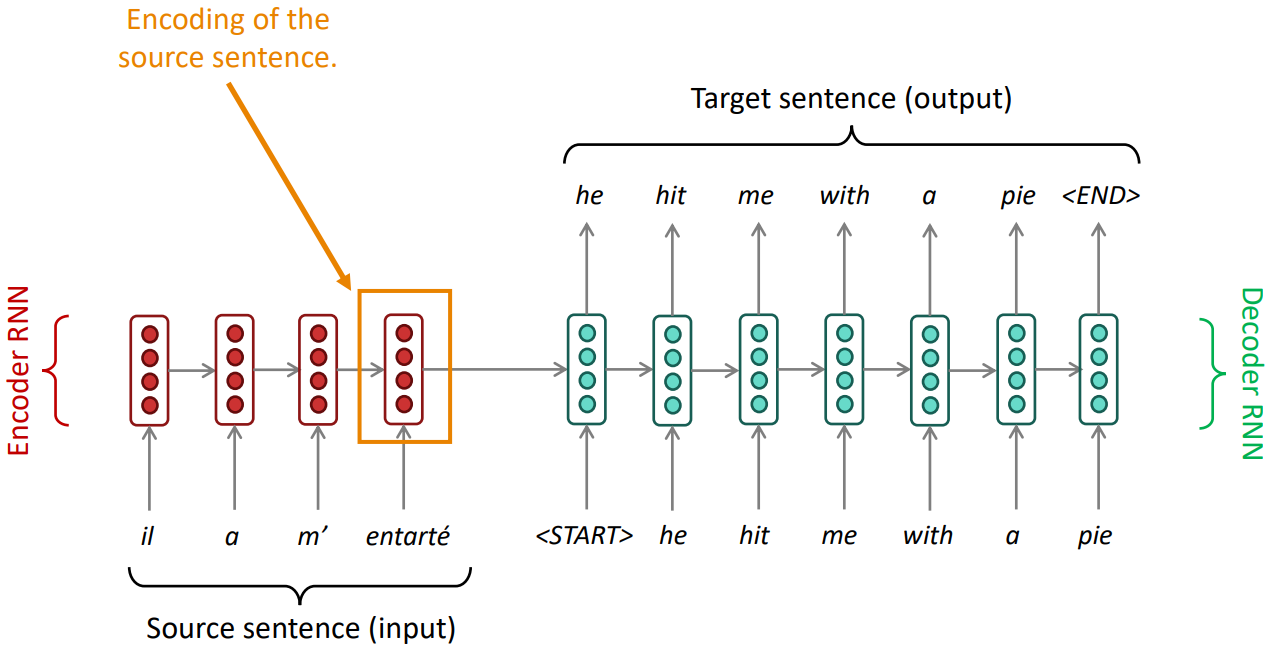
-
Information bottlenect: the last hidden state of encoder RNN needs to capture all information about the source sentence.
-
Core idea: on each step of the decoder, use direct connection to the encoder to focus on a particular part of the source sequence
- Each step, dot products a decoder hidden state to all encoder hidden states and get Attention scores
- Take softmax to turn scores into Attention distribution
- Using this distribution, take a weighted sum of the encoder hidden states to calculate Attention output
- Concatenate with decoder hidden state, predict $\hat{y_i}$
